The pilgrimage to Kailas-Manasarovar, at 15,000 ft. above sea level, is one of the most challenging and difficult of all pilgrimages. Swami Pranavanandaji (1896), a sannyasi, completed 23 circumambulations of Mt. Kailas and 25 of Manasarovar. In his pilgrimage in 1936-37 he spent a whole year and in 1943-44 spent a full 16 months by the shores of Manasarovar. From his experiences he advises that anyone who has strong lungs, a sound heart and who is not suffering from high blood pressure can undertake the journey. Swami Pranavanandaji lists the articles needed for the Kailas-Manasarovar pilgrimage in his book, Kailas-Manasarovar (p.181-184). He says that 22 types of clothes and wear, over 24 different medicines and 40 miscellaneous articles are required.
Nilkanth Varni, on the other hand, travelled in the middle of winter, with the barest of means and all by himself. To get an idea of Nilkanth's austere pilgrimage, here is a list of what he had and the requirements listed by Swami Pranavanandaji.
Nilkanth's Possessions
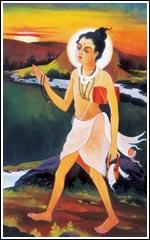
Clothes: loincloth, waist-cloth, a filter cloth
Miscellaneous: a gourd (kamandal), mala (rosary), Shaligram contained in a small cane case (batvo), deer skin and staff.
Requirements for Pilgrims
Clothes
1. 2 or 3 good woollen blankets. 2. Chutka (thick Tibetan blanket, to be hired or bought at Garbyang or at Taklakot). 3. Bedding according to one's own requirements. 4. 1 Woollen shirt. 5. 2 Woollen pyjamas or trousers. 6. 1 Woollen sweater. 7. 2 Pairs of woollen stockings. 8. 1 Woollen muffler. 9. 1 Pair of woollen gloves 10. 1 Pair of pattis for legs. 11. 1 Woollen balaclava cap (monkey-cap). 12. 1 Woollen overcoat. 13. 1 Light waterproof coat. 14. 1 Waterproof covering for the hat when one is taking a hat. 15. 2 or 3 Pieces of oil-cloth or waterproof to cover the bedding and luggage. 16. 4 Cotton shirts. 17. 1 Pair of cotton pyjamas. 18. 1 Pair of dhotis. 19. 1 Pair of towels. 20. 3 or 4 yards of spare cloth. 21. 1 Pair of strong full-boots, preferably of canvas and one pair of ordinary shoes. 22. 1 Umbrella.
Medicines
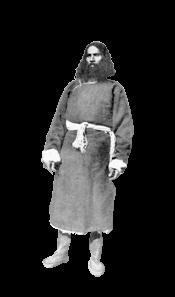 1. Chlorodyne, Camphorodyne or Bismuth - for diarrhoea. 2. Salphagannidine or Dover's powder - for dysentery. 3. For indigestion: Soda bicarb, Bhaskar-lavan. 4. Fruit salt - for indigestion and free motion. 5. Mepacrine or Palludrine tablets - for malaria. 6. For dressing wounds, cuts, boils, etc.: Sticking plaster, Potassium Permanganate, Tincture of Iodine, Acid Boric and Sulphanilamide powder, Absorbent cotton. 7. Rolled bandages. 8. A.B.C. liniment - for pain in joints. 9. Cafiaspirin or Aspro - for headaches, slight indispositions, aching limbs, etc. 10. Influenza mixture. 11. Purgative pills. 12. Vaseline bottles - for applying to face, nose, and hands in cold places. 13. Amritdhara and Amrutanjan for all complaints. 14. For colds: Smelling salt, Vapex. 15. Ginger chips or some citrus articles - for billiousness. 16. J.J. Dechen's People's Medical Service Set. 17. D.D.T. Powder - for bugs, flies, lice, etc. 18. Carbolic acid or some other toothache cure. 19. Tooth-brush and tooth-powder. 20. Enema can or syringe. 21. Rubber catheter. 22. Hot water bag. 23. Clinical Thermometer. 24. Cibazal tablets - for pneumonia and bronchitis.
1. Chlorodyne, Camphorodyne or Bismuth - for diarrhoea. 2. Salphagannidine or Dover's powder - for dysentery. 3. For indigestion: Soda bicarb, Bhaskar-lavan. 4. Fruit salt - for indigestion and free motion. 5. Mepacrine or Palludrine tablets - for malaria. 6. For dressing wounds, cuts, boils, etc.: Sticking plaster, Potassium Permanganate, Tincture of Iodine, Acid Boric and Sulphanilamide powder, Absorbent cotton. 7. Rolled bandages. 8. A.B.C. liniment - for pain in joints. 9. Cafiaspirin or Aspro - for headaches, slight indispositions, aching limbs, etc. 10. Influenza mixture. 11. Purgative pills. 12. Vaseline bottles - for applying to face, nose, and hands in cold places. 13. Amritdhara and Amrutanjan for all complaints. 14. For colds: Smelling salt, Vapex. 15. Ginger chips or some citrus articles - for billiousness. 16. J.J. Dechen's People's Medical Service Set. 17. D.D.T. Powder - for bugs, flies, lice, etc. 18. Carbolic acid or some other toothache cure. 19. Tooth-brush and tooth-powder. 20. Enema can or syringe. 21. Rubber catheter. 22. Hot water bag. 23. Clinical Thermometer. 24. Cibazal tablets - for pneumonia and bronchitis.
Miscellaneous Articles
1. Torch light with spare batteries. 2. Candles. 3. Hurricane lantern. 4. Kashmiri Kangri (an earthen pot for holding fire, encased in an indigenous willow-basket, generally carried under the long loose cloak, for keeping the body warm; can be secured from some Kashmiri friend). 5. Stove with accessories including methylated spirit. 6. Kerosene oil (to be taken from Almora). 7. Match boxes. 8. Portable cooking vessels, ladle, dishes, plates, tea-kettle, cups, spoons, tiffin carrier, etc. 9. Pressure, Ic-mic, Annapurna, or Rukmini Cooker (rice is not well cooked in ordinary vessels at altitudes above 10,000 ft.) 10. Thermos flask. 11. 2 Buckets or empty tins with handles - for fetching and heating water on the way. 12. 1 or 2 light package boxes for keeping vessels, kettle, cups, bottles, and such other breakables. 13. 1 Tin with lock - for keeping sweets
and other eatables (often pilgrims complain against servants for pilfering eatables). 14. 2 Gunny bags - for putting the holdall and other boxes so as to be portable for carrying either by coolies or ponies. 15. 2 Kit-bags with locking arrangement. 16. 6 Small cloth bags for bringing Kailas-incense and other articles on the return journey. 17. 2 Ropes, each 20 feet long. 18. Knife. 19. A pair of scissors. 20. Hand axe. 21. 2 Locks 22. Soaps for bathing and washing. 23. Stick with an iron point (to be bought at Haldwani or Almora). 24. A pair of green goggles to protect eyes from snow-glare and the effects of the severe cold winds. 25. Binocular. 26. One good portable camera with sufficient number of roll films or film packs. 27. Kodak's magnesium ribbon holder, ordinary magnesium ribbon, or flash powder for taking photos in dark rooms, as at Khochar and for seeing clearly the caves, as at Dira-phuk, Zuthul-phuk, and other places. 28. Maximum and Minimum Thermometer. 29. Centigrade Thermometer for measuring temperatures of thermal springs. 30. One portable aneroid barometer. 31. Some toys, soaps, mirrors, cigarettes, and other petty presents to servants, horse-men, and to the monks of the monasteries.
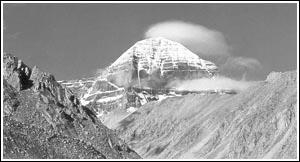 32. Dried vegetables. 33. Spices, pickles, chutneys, tamarind, dried mango pieces, etc. 34. Dry fruits - grapes, kismis, dates, almonds, etc. 35. Tea, ovaltine, condensed milk, milk-powder, corn-flakes, the sweets of bal (made of evapourated milk with a little sugar) and chocolates of Almora, biscuits, lemon-drops, lozenges, sweetto, sugar-cubes, sugar-candy, etc. 36. Stationery, papers, pencils, pens, ink-bottles, postage-stamps, envelopes, cards, needles and thread, etc., a copy of the Bhagvad-Gita and copy of Bhajans. 37. Spring-balance which can weigh up to 100 lbs. - for weighing luggage at different stages. 38. 3 or 4 empty hydrogen peroxide bottles or some other strong bottles with good corks for bringing the Holy waters of Kailas, Manasarovar, Gauri-kund, and Tirthapuri hot springs. 39. 1 Pair of double-panniers (two thick bags tied together) for each person - for keeping eatables and other miscellaneous articles to be placed on the riding-pony. 40. Camphor, dhup, sopari, agarbatti, wicks soaked in ghee, vermillion, cardamom, and sundry articles which the pilgrim might choose to carry.
32. Dried vegetables. 33. Spices, pickles, chutneys, tamarind, dried mango pieces, etc. 34. Dry fruits - grapes, kismis, dates, almonds, etc. 35. Tea, ovaltine, condensed milk, milk-powder, corn-flakes, the sweets of bal (made of evapourated milk with a little sugar) and chocolates of Almora, biscuits, lemon-drops, lozenges, sweetto, sugar-cubes, sugar-candy, etc. 36. Stationery, papers, pencils, pens, ink-bottles, postage-stamps, envelopes, cards, needles and thread, etc., a copy of the Bhagvad-Gita and copy of Bhajans. 37. Spring-balance which can weigh up to 100 lbs. - for weighing luggage at different stages. 38. 3 or 4 empty hydrogen peroxide bottles or some other strong bottles with good corks for bringing the Holy waters of Kailas, Manasarovar, Gauri-kund, and Tirthapuri hot springs. 39. 1 Pair of double-panniers (two thick bags tied together) for each person - for keeping eatables and other miscellaneous articles to be placed on the riding-pony. 40. Camphor, dhup, sopari, agarbatti, wicks soaked in ghee, vermillion, cardamom, and sundry articles which the pilgrim might choose to carry.
Briefs on holy Places
Kedarnath, Badrinath, Joshimath, Kailas-Manasarovar, Gangotri
Kedarnath
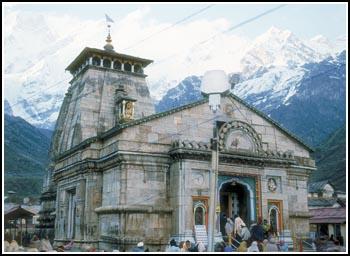 Amidst the dramatic mountainscapes of the majestic Kedarnath range stands one of the twelve 'Jyotirlings' of Kedar or Lord Shiv. Lying at an altitude of 11,758 ft. on the head of river Mandakini, the shrine of Kedarnath is amongst the holiest pilgrimages for the Hindus.
Amidst the dramatic mountainscapes of the majestic Kedarnath range stands one of the twelve 'Jyotirlings' of Kedar or Lord Shiv. Lying at an altitude of 11,758 ft. on the head of river Mandakini, the shrine of Kedarnath is amongst the holiest pilgrimages for the Hindus.
The origin of the revered temple can be found in the great epic - Mahabharat. According to legend, the Pandavas sought the blessings of Lord Shiv to atone their sins after the battle of Mahabharat. Lord Shiv eluded them repeatedly and while fleeing took refuge at Kedarnath in the form of a bull. On being followed, he dived into the ground, leaving behind his hump on the surface. This conical protrusion is worshipped as the Jyotirling murti in the shrine. The remaining portions of Lord Shiv are worshipped at four other places - the arms (bahu) at Tungnath, mouth (mukh) at Rudranath, navel (nabhi) at Madmaheshwar and hair (jata) at Kalpeshwar. Together with Kedarnath, these places are known as the Panch Kedar.
The present Kedarnath mandir, built in 800 AD by Adi Guru Shankaracharya lies adjacent to the site of an ancient temple built by the Pandavas. The walls of the exquisitely architectured mandir are embellished with figures of deities and scenes from mythology. The mandir has a conical lingam - the main idol, a statue of Nandi - the celestial bull, a 'garbha grah' for assemblies of pilgrims and visitors. The mandir is believed to be more than 1,000 years old.
Kedarnath is 234 km from Rishikesh.
Badrinath
Badrinath is considered the holiest of the four shrines in Garhwal. The town is at an altitude of 10,272 ft. above sea level, situated on the left bank of river Alaknanda and exactly between the two mountains of Nara and Narayan. The shrine is dedicated to Bhagwan Vishnu.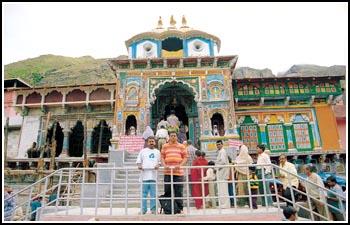
The present mandir was built about two centuries ago by Garhwal Kings. It is a conical structure, 49 ft. tall and has small cupola of a gilt bull and spire. There are 15 murtis in the mandir complex, each sculpted in black stone. The principal murti represents Vishnu, called Badrinath, in a meditative posture and is flanked by Nara-Narayan. Legend dates it prior to the Vedic age though it is believed to have been re-established by Adi Shankaracharya, an important Hindu saint in 8th century A.D. Some of the other images include Lakshmi (Vishnu's consort), Garud (Vishnu's mount) Shiv and Parvati and Ganesh.
On the route to Badrinath there is a pilgrimage place called Pandukeshwar where the Pandavas are believed to have been born. Bhagwan Vishnu is believed to have done his austerities at this place.
Joshimath
The winter home of Shri Badrinathji is situated on the slopes above the confluence of Alaknanda and Dhaulitganga. It is one of the four 'maths' established by Adi Guru Shankaracharya. It is approximately 44 km from Badrinath.
Kailas-Manasarovar
Mount Kailas
Mt. Kailas, the abode of Lord Shiv and goddess Parvati, is one of the highest mountains in Tibet at 22,022 feet. The Buddhists, the Jains and the Bonpas of Tibet too, all revere this spot with great fervour and devotion.
For Hindus, Mt. Kailas is the earthly manifestation of Mt. Meru, the spiritual centre of the universe around which all else revolves. Kailas-Manasarovar is 865-kms from Delhi.
Manasarovar
Manasarovar is 30 km southeast of Mt. Kailas. The lake was where the sons of Brahma performed austerities. At their request Brahma created it from his mind so that they could bathe and purify
(Contd. p. 40)
(Contd. from p. 37)
themselves for their daily oblations and rituals.
Gangotri
Couched in the magnificent Garhwal hills, Gangotri, the origin of river Ganga, is at an altitude of 10,000 ft. above sea level. It is on the northernmost part of the state of Uttar Pradesh and is very near the Indo-Tibetan border.
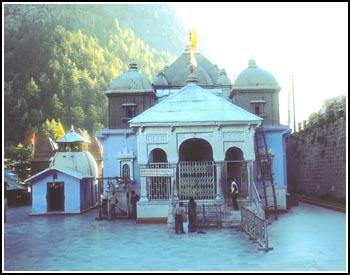 It is approximately 300 km from Dehradun, 250 km from Rishikesh and 105 km from Uttarkashi. Gangotri is 18 km further north of Gaumukh. The summers are relatively cool and winters are freezing cold, with rains in the months of May and June. For the devotees and tourists, the gates of the temple are open only in the months of May to November.
It is approximately 300 km from Dehradun, 250 km from Rishikesh and 105 km from Uttarkashi. Gangotri is 18 km further north of Gaumukh. The summers are relatively cool and winters are freezing cold, with rains in the months of May and June. For the devotees and tourists, the gates of the temple are open only in the months of May to November.